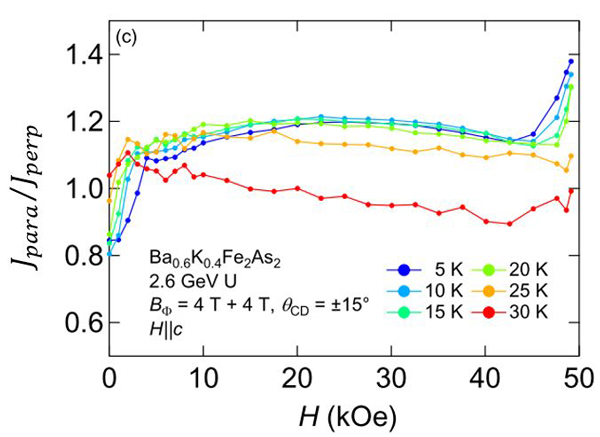PC9-5
Anisotropic Critical Current Densities in Ba0.6K0.4Fe2As2 Superconductors with Splayed Columnar Defects
Dec.3 17:15-17:30 (Tokyo Time)
Department of Applied Physics, The University of Tokyo, Japan1
Nishina Center, RIKEN, Japan2
Department of Physics and Mathematics, Aoyama Gaguin University, Japan3
Columnar defects (CDs) were proved to enhance the critical current density (Jc) in cuprate superconductors [1], and further enhancement is reported by splaying the direction of CDs [2]. In the case of Ba1-xKxFe2As2, the Jc enhancement also occurs with a non-monotonic field dependence, namely the anomalous peak effect [3,4].
In the present study, Ba0.6K0.4Fe2As2 crystals were irradiated by 2.6 GeV U ions from two directions, each with a dose-equivalent magnetic field BΦ = 4 T. We controlled splay angles (θCD), which are angles between incident directions and the c-axis, by tilting the ab-plane of samples during the irradiation. By introducing splayed CDs, which break in-plane symmetry, Jc is expected to have an in-plane anisotropy [5]. So, the two components Jpara and Jperp that are parallel and perpendicular to the splay plane, respectively, need to be figured out to determine which component contributes more to the anomalous peak effect. The magneto-optical (MO) imaging can be implemented to determine them but requires observation under high fields in this case, which is difficult using a garnet film with a low saturation field. Thus, the MO imaging was only used for the detection of macroscopic defects. The in-plane anisotropy of Jc is evaluated based on the magnetization data obtained for two separate samples with different in-plane aspect ratio with respect to the splay plane. Generally, the Bean model is used to calculate the average Jc of rectangular superconductors under an assumption of constant in-plane Jc. After picking up two rectangular pieces with different aspect ratios from the original sample (θCD = ± 15°), Jc in the two directions were evaluated to reveal the splayed CDs-induced anisotropy in in-plane Jc. Calculated magnetic field dependence of in-plane anisotropy of Jc, Jpara / Jperp are shown in Fig. 1. It clearly shows that Jpara contributes more to the anomalous peak effect at around 25 kOe.
[1] L. Civale et al., Phys. Rev. Lett. 67, 648 (1991).
[2] L. Krusin-Elbaum et al., Phys. Rev. Lett. 76, 2563 (1996).
[3] A. Takahashi et al., J. Phys. Soc. Jpn. 89, 094705 (2020).
[4] A. Park et al., Phys. Rev. B 97, 064516 (2018).
[5] A. Park et al., Physica C 530, 58 (2016).
Fig. 1. Magnetic field dependence of in-plane anisotropy of Jc, Jpara / Jperp at various temperatures for Ba0.6K0.4Fe2As2 (θCD = ± 15°, BΦ = 4 T + 4 T).
Keywords: Iron-based superconductor, Critical current density, Anomalous peak effect, Columnar defects
